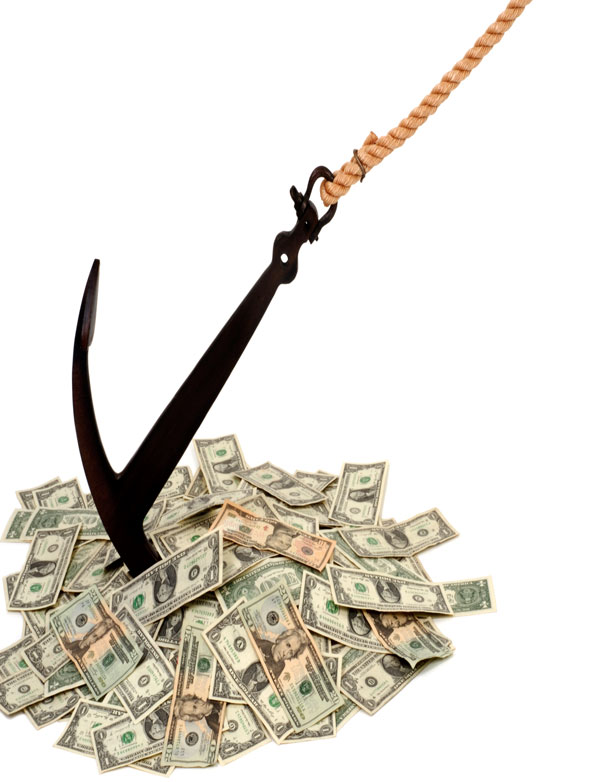We like to think we are rational decision-makers, but if you have read any of our blog entries (here, or here, or here, for instance) or, indeed, any of dozens of popular books about how we decide (e.g., How We Decide, Blink, Predictably Irrational), then you’ll already know it just ain’t so. We are pretty quirky when it comes to how we process information on the way to making decisions, and these quirks can certainly cost us money.
 The anchoring bias is so named because when we are faced with making a decision involving numbers, we tend to become stuck on the first number we see. For instance, if you are doing some shopping on line and you reach a web page that has a listing of items and their prices, how you evaluate the price of each item on the list will be influenced by which price you see first. If you see a high price first, you will expect (and be more comfortable with) high prices from then on.
The anchoring bias is so named because when we are faced with making a decision involving numbers, we tend to become stuck on the first number we see. For instance, if you are doing some shopping on line and you reach a web page that has a listing of items and their prices, how you evaluate the price of each item on the list will be influenced by which price you see first. If you see a high price first, you will expect (and be more comfortable with) high prices from then on.
Marketers know these things, of course, and the good ones will be certain that you do see the high prices first. Moreover, many product lines are constructed so that there is a high-end item priced well above what most consumers are willing to pay, simply to anchor potential customers to a higher price. We are much more willing to pay $50.00 for a bottle of wine at a restaurant when there is a $300.00 bottle on the menu, even if we never consider buying the more expensive bottle. That $300.00 bottle makes the restaurant a lot of money even if no one ever buys it. Restaurant owners who didn’t know that and who took the non-selling bottle off the list would find their sales of $50.00 bottles drop.
But it gets better.
As it turns out, the anchors don’t have to be related in any way to what we are making a decision about to have an effect. For instance, if I were to tell half of you that it was 100 degrees in Palm Springs yesterday and tell the other half that there was a 15% chance of rain in San Francisco tomorrow, then ask both groups how old Justin Bieber is, the Palm Springs group would produce an average guess that was substantially older than the San Francisco group.
Hearing the temperature can impact how old you think Justin Bieber is. It can also impact how much you are willing to spend on virtually anything. In fact, any number presented at random can influence your judgement about everything from people’s ages to the heights of mountains. The only factor that seems to reduce this bias is expertise. If you really know the subject, you are less susceptible.
What’s more, being a conscientious and thoughtful person actually makes matters worse, not better. Another of our mental biases, the confirmation bias, kicks in more strongly in the conscientious types. More on the confirmation bias in another post. For now, it’s enough to know that we tend to selectively look for and recall information that is consistent with what we already know — or as it turns out, just happen to see. Even if the number we are anchored on is completely random, our brains lock on to the number and then get into gear producing all the rationale that will be required to support believing that Justin Bieber is really older than he is (he’s really 18).
Unfortunately, the anchoring bias is not one of the mental quirks that we can easily defeat through simple awareness. Your best bet for not falling prey to the anchoring bias is to know what you can and should pay for something you want before you go shopping, so that when you see or hear numbers at odds with that, you can simply turn away.
If you are skeptical, or if you just want to have some fun, try this one at home. It’s easy to do and makes a good parlor trick. Or poker trick. You get the idea.
At BeyondThePurchase.Org, we are researching the connection between people’s spending habits, happiness, and values and are interested in all of the influences on how we spend money.
To find out more about how your personality and values influence how you relate to money and spending, we encourage you to take our hidden buying motivations test, Consumer Susceptibility to Interpersonal Influence Scale, and the Materialistic Values Scale and Experiential Buying Tendencies Scales tests and find out about your own values — as well as those of your friends. We think you may learn a lot about how you and why you spend your money the way you do.
To learn about your spending habits, what influences your buying behavior, and how you define the good life, first Login or Register with Beyond The Purchase.
This blog post was written by Kerry Cunningham, a recent graduate of the Personality & Wellbeing Laboratory at San Francisco State University.Follow @kerryfc

